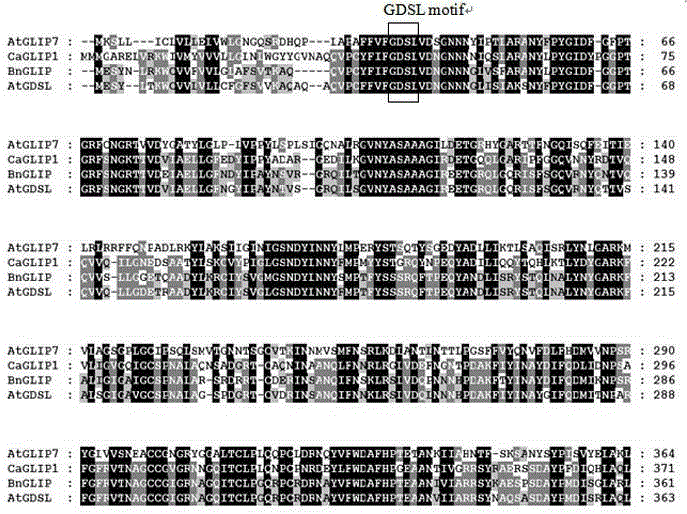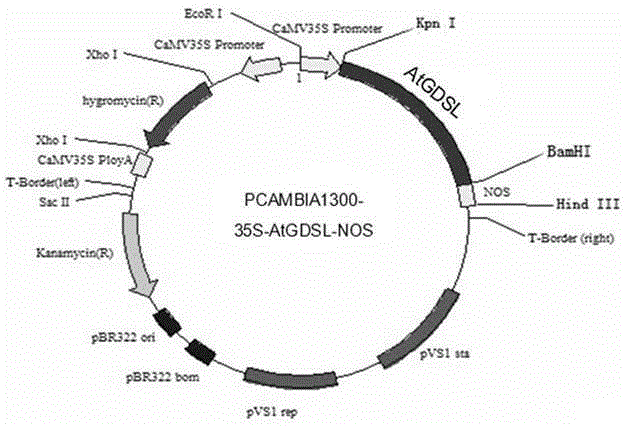Application of Arabidopis thaliana AtGDSL gene in prevention of sclerotinia rot and promotion of seed germination of rape
An Arabidopsis, gene technology, applied in the field of plant genetic engineering and biology, can solve very few problems, and achieve the effects of low cost, simple operation and fast speed
- Summary
- Abstract
- Description
- Claims
- Application Information
AI Technical Summary
Problems solved by technology
Method used
Image
Examples
Embodiment 1
[0036] Example 1: AtGDSL Gene acquisition
[0037] 1. Seedling cultivation
[0038] The wild-type Arabidopsis was used as the experimental material, and the growth conditions were as follows: temperature 20±2°C; humidity 60-90%; daily photoperiod of 8 hours of light and 16 hours of darkness; light intensity of 44 μmolm –2s–1 .
[0039] 2. RNA extraction and cDNA first-strand synthesis
[0040] RNA extraction: Use UNIQ-10 column Trizol kit (purchased from Shanghai Yingjun Biotechnology Co., Ltd.), take a small amount of sample, freeze it with liquid nitrogen in a mortar, grind it into powder, add 1mL TRNzol-A reagent (day Root Biochemical Technology Co., Ltd.) in a 2mLEP tube, after fully shaking, centrifuge at 4°C, 12000rpm for 10min; then take about 800μL of the supernatant, add 300μL of chloroform (pre-cooling is easy for separation), shake vigorously for 15s, and place at room temperature for 3min; After centrifugation at 12,000 rpm at 4°C for 10 min, transfer abo...
Embodiment 2
[0054] Embodiment 2: construct overexpression AtGDSL Transgenic Rapeseed Plants
[0055] 1. AtGDSL Overexpression vector construction
[0056] Add the CaMV35S strong promoter to the upstream EcoRI / KpnI restriction site of the vector pCAMBIA1300 (Beijing Dingguo Changsheng Biotechnology Co., Ltd.), and add the CaMVNos terminator to the downstream BamHI / HindIII restriction site to transform it into Recombinant vector pCAMBIA1300-35S-Nos. The specific process is as follows:
[0057] The specific process is as follows: according to the CaMV35S sequence (GeneID: AJ007626) published on NCBI, use PrimerPremier5.0 software to design primers: upstream primer: 5′- GAATTC TTAATTAAGAGCTCGCATGCC-3' (SEQ ID NO.5) contains EcoRI restriction site (underlined part), downstream primer: 5'- GGTACC GTCCCCGTGTTTCTCCAA-3' (SEQ ID NO.6) contains the KpnI restriction site (underlined part), and the CaMV35S fragment was amplified from the pEGAD vector (purchased from Bao Biotechnology (Dali...
Embodiment 3
[0082] Example 3: Overexpression AtGDSL Response of Rapeseed Rapeseed Plants to Sclerotinia Infection
[0083] Sclerotia sclerotia were cultured in PDA medium. PDA medium (1L) formula: 200g potato, 10-20g sucrose, 17-20g agar powder, 1000g double distilled water; cut the peeled potato into small pieces, add 800mL water, boil for 0.5h, filter the residue with gauze, add water Make up 1000mL, then add sugar and agar, heat to melt the agar completely, aliquot while hot, and autoclave for later use.
[0084] Take the four-leaf-one-heart stage of the above-mentioned PCR test positive AtGDSL The fourth true leaf of positive plants was inoculated in vitro. Cut the leaves and place them in a white porcelain plate. The leaves of each transgenic plant and the non-transgenic control are placed side by side in a plate, and a layer of wet gauze is laid under the leaves. Take a freshly prepared φ5mm mycelium block, with the mycelium side facing down. , inoculated at the position sligh...
PUM
 Login to View More
Login to View More Abstract
Description
Claims
Application Information
 Login to View More
Login to View More - R&D
- Intellectual Property
- Life Sciences
- Materials
- Tech Scout
- Unparalleled Data Quality
- Higher Quality Content
- 60% Fewer Hallucinations
Browse by: Latest US Patents, China's latest patents, Technical Efficacy Thesaurus, Application Domain, Technology Topic, Popular Technical Reports.
© 2025 PatSnap. All rights reserved.Legal|Privacy policy|Modern Slavery Act Transparency Statement|Sitemap|About US| Contact US: help@patsnap.com



